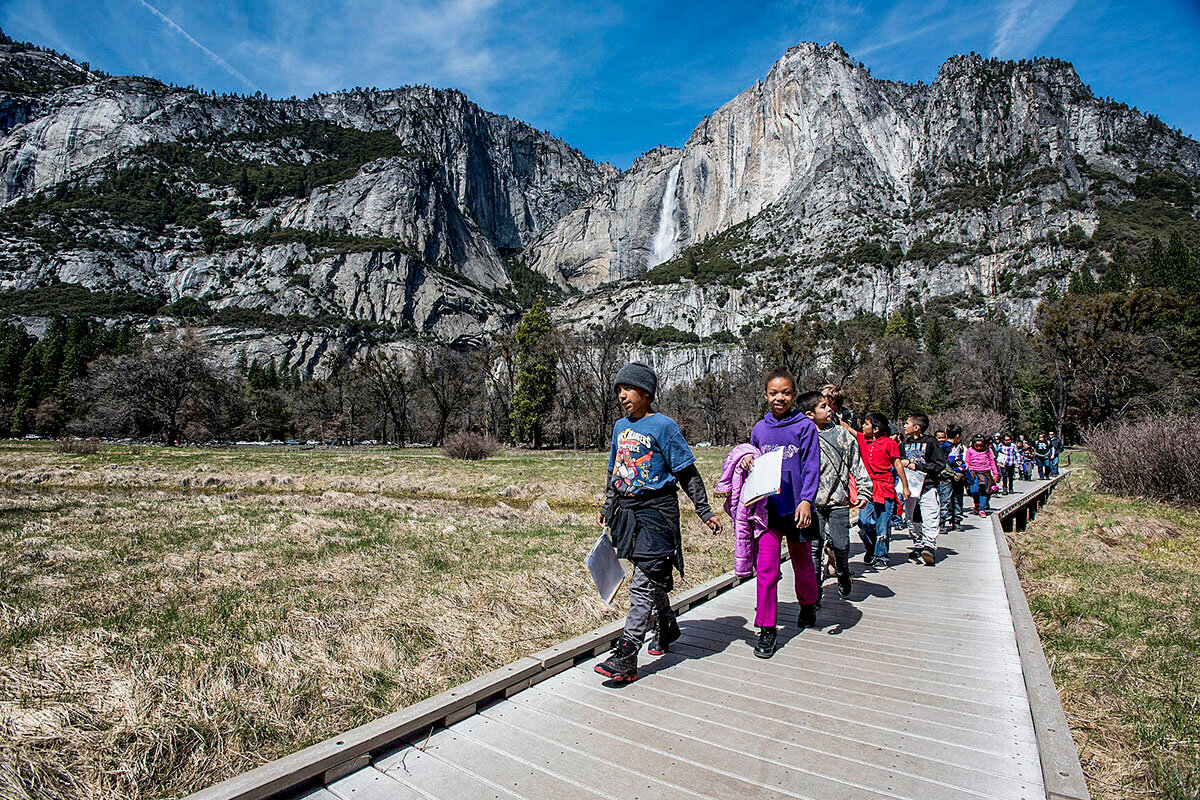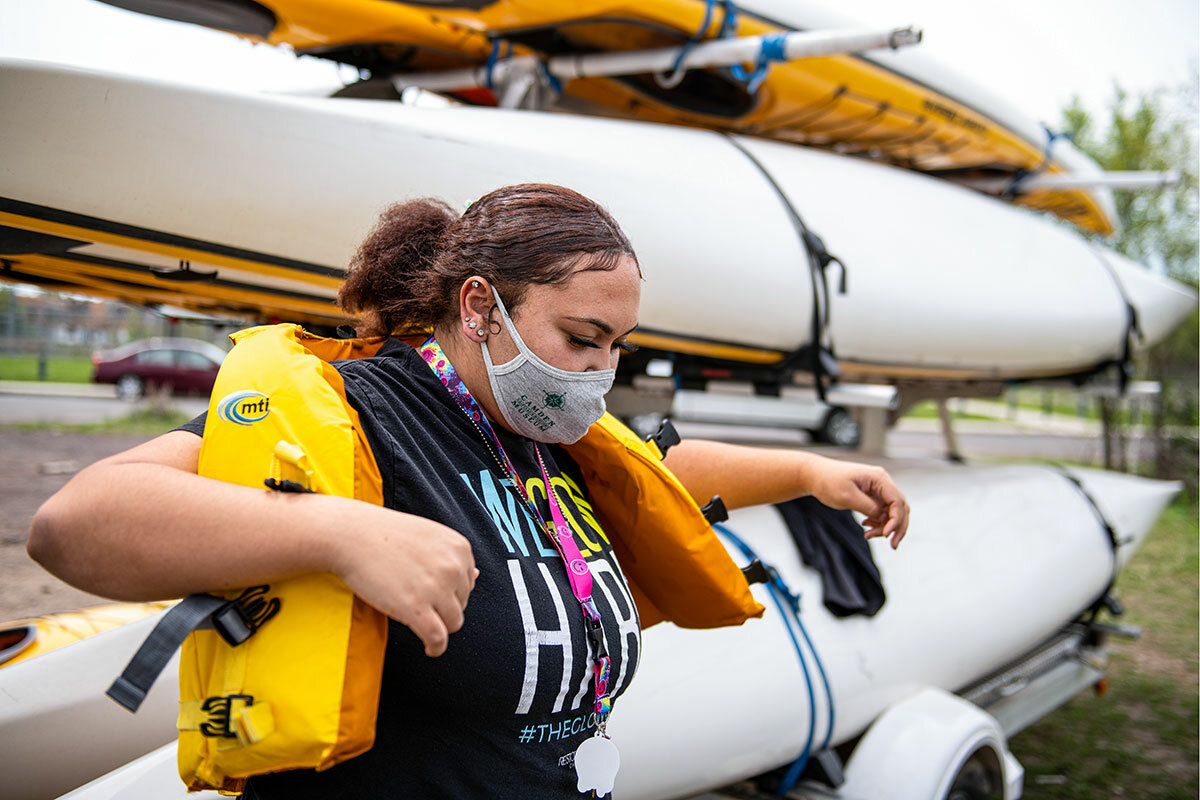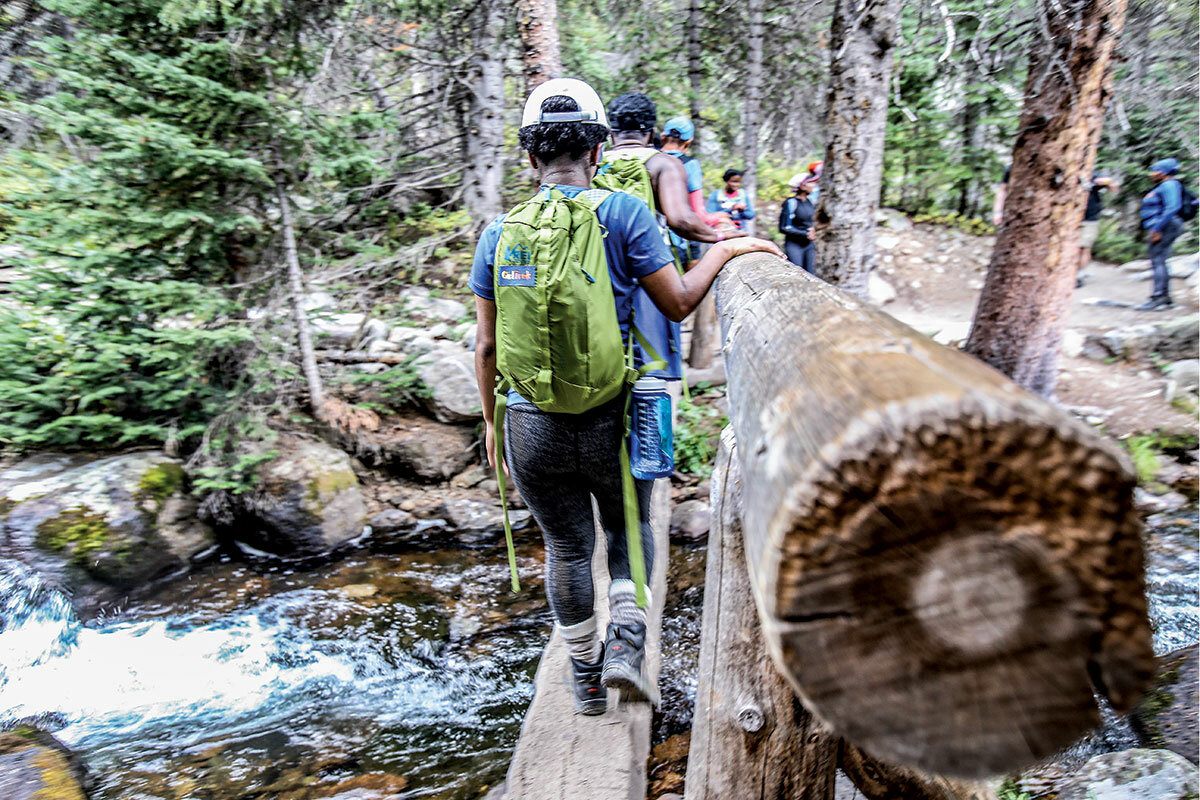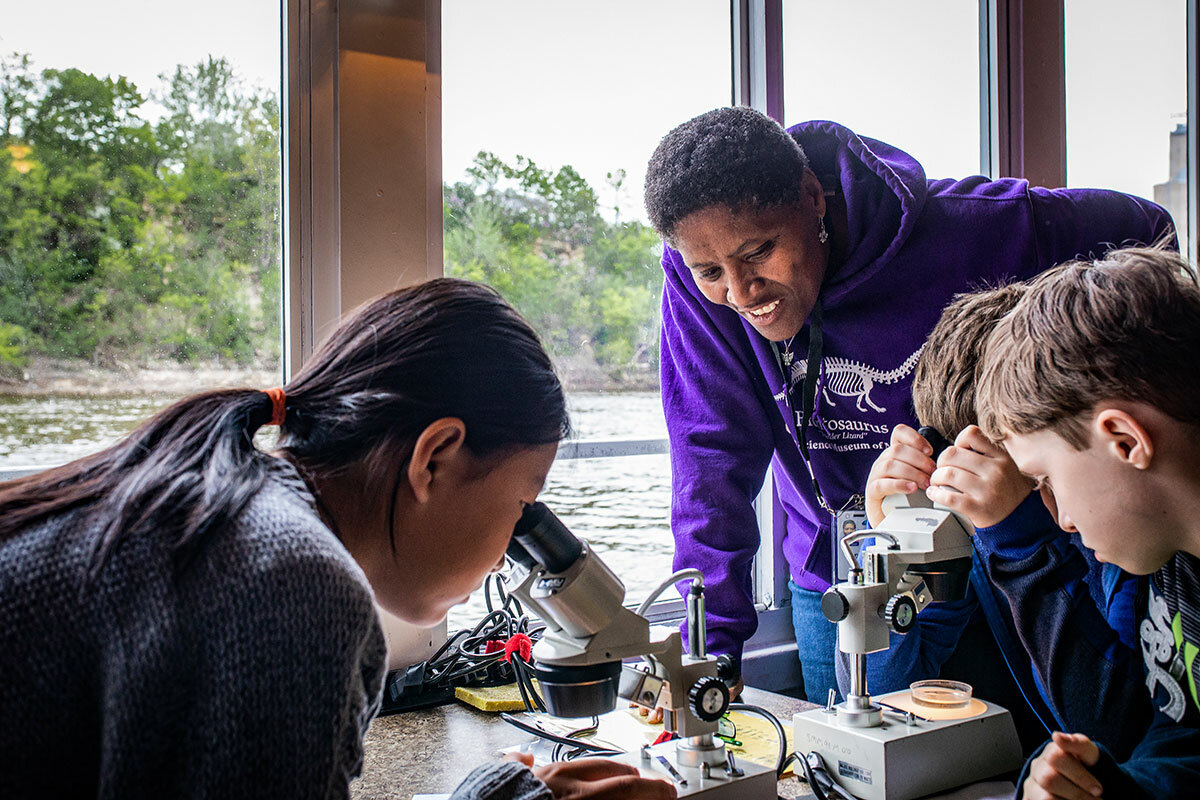The great outdoors has a diversity problem. Can it be fixed?
Loading...
Public lands are perhaps America’s most democratic idea.
In theory.
Why We Wrote This
The country’s racial reckoning has exposed an underlying truth about America’s outdoors: that inequality extends to nature. Some children grow up with access to wilderness, while others face barriers that keep them out.
But a closer look reveals America’s great outdoors – from rivers to mountains, national parks to community recreation centers – are marred by the same social and racial inequality present in other parts of American society.
“We’re a country built on the idea of having community parks, rec centers, state parks, county parks, national parks, and public lands,” says Lise Aangeenbrug, executive director of the Outdoor Industry Association. “They’re open to everyone. But just because it’s there, not everyone feels welcome. Not everyone has the resources to get there or to experience it in a fun or safe way.”
The causes are complex, and sometimes layered in decades or centuries of history, but the results are clear: Access to and use of America’s outdoors don’t reflect the diversity of the nation. But that doesn’t mean people aren’t trying to change that.
“We want kids, we want everybody to have those choices to find joy in the outdoors,” says Carolyn Finney, author of “Black Faces, White Spaces.”
And engaging new people now is a key to changing the outdoors tomorrow, Ms. Finney says: “Who we see, and what stories are told, that affects younger people.”
Late one evening in October 2019, Don Baugh beached his kayak on the rocky shore of Pyne Poynt Park, a 15-acre postindustrial green space abutting a polluted backwater in Camden, New Jersey. Mr. Baugh runs an environmental nonprofit called Upstream Alliance, and he’d spent the day on the water pointing out sewage outflows to staff from New Jersey’s Department of Environmental Protection.
Now it was dusk, and Mr. Baugh wanted to load his boat and leave before dark. Across the Delaware River from Philadelphia, Camden is one of America’s poorest cities, and, until recently, one of its most murderous. This park in particular had a history of violent crime.
That’s why he was nervous when a boy of about 16 came zipping up the path on a dirt bike. The youth stopped near Mr. Baugh and watched him work.
Why We Wrote This
The country’s racial reckoning has exposed an underlying truth about America’s outdoors: that inequality extends to nature. Some children grow up with access to wilderness, while others face barriers that keep them out.
“You’re a white guy,” said the boy, who was Latino. “White guys don’t come over to this side very much.”
The youth introduced himself as Angelo. He gestured to one of the kayaks. “How much is one of those things?”
Mr. Baugh looked at his kayak, a Current Designs touring model that retails for $3,000. Not wanting to deter the boy, he said: “Well, you can get a sit-on-top kayak for about $400. I’ll take you out sometime, if you want.”
“I’d like that,” Angelo said. “But $400 is too much.”
Mr. Baugh’s upper-middle-class childhood was a world apart from Angelo’s. Blessed with access and resources, Mr. Baugh spent his youth in nature, paddling his canoe up tributaries of Maryland’s Severn River. His mentors were environmentalists and engineers. He went to college, majored in conservation, and worked for 38 years at the Chesapeake Bay Foundation. Most days he commuted in a sea kayak – seven miles each way. For Mr. Baugh’s whole life, nature has mentally, physically, and financially enriched him.
Now in his 60s, Mr. Baugh lives aboard a 34-foot sailboat in a Philadelphia marina. He’s spending his life’s second act paddling the waterways around Angelo’s hometown, advocating for cleaner water with better public access, and designing free programs to get Camden’s children outside. He’s trying to break down economic, social, and environmental barriers to make people like Angelo feel as entitled to nature as he did.
“I didn’t worry about nature,” Mr. Baugh says. “Nature was inviting to me.”
That evening in the park, Mr. Baugh and Angelo were on the same side of the river. But they were also on two sides of a divide that threatens America’s public health and the future of its open spaces: Who finds belonging in nature, and who grows up estranged from it?
Last year, when the murder of George Floyd heightened awareness of the country’s racial inequities, protests erupted on the grounds of state capitols and in the commercial cores of America’s biggest cities.
At the same time, many Americans were seeking solace in the wilderness, which felt apart from both the pandemic and systemic racism. After all, wasn’t nature the one place where equality was guaranteed?
But generations of racism don’t end at a trailhead, just as they didn’t with the 13th Amendment. The country’s racial reckoning and the enduring pandemic have exposed an underlying truth in America’s outdoor community: that racial and social inequality extends into the wilderness because some children grow up with access to the outdoors, while others are shut out.
In theory, public lands are America’s most democratic idea. According to the U.S. Geological Survey, more than 726 million acres – a third of the nation – are protected from development for the benefit of all Americans. If that land were distributed equally, each American child would get more than 10 acres – roughly four city blocks.
But historically, America’s open spaces were founded by and for white people. Beginning with Yellowstone in 1872, many national parks were created by legislation with little regard to the historical territories of Native American tribes, or were negotiated from tribes via treaties that the U.S. government promptly breached. Until the middle of the last century, national parks still segregated people of color.
Today, childhood participation in outdoor recreation is declining, a disconnect most pronounced among marginalized communities and low-income families.
“We’re a country built on the idea of having community parks, rec centers, state parks, county parks, national parks, and public lands,” says Lise Aangeenbrug, executive director of the Outdoor Industry Association. “They’re open to everyone. But just because it’s there, not everyone feels welcome. Not everyone has the resources to get there or to experience it in a fun or safe way.”
To get exercise, stay healthy, or just escape the monotony of pandemic life, many Americans have recently taken up walking, biking, running, and hiking close to home, according to a report from the Outdoor Foundation. These new outdoor participants are slightly more diverse than pre-pandemic numbers, but they are still 66% white. And it’s unclear if these habits will stick.
What is clear is that the overall pool of people who recreate outdoors in America is small. According to a 2020 Outdoor Foundation report, half of Americans aren’t active outside even once a year. The people who are getting outside look a lot like they always have: mostly white, mostly male, and mostly living in households with above-average incomes.
“When you live in Boulder or Bozeman, everybody gets outside,” says Ms. Aangeenbrug. “That’s not true in the rest of the U.S. It’s not the norm anymore.”
Recent research has discovered myriad health benefits of time outside. A 2019 study from Denmark shows that simply growing up near green space accounts for a 55% lower risk of developing mental health disorders in adulthood.
Children especially benefit from nature. Studies show that time outside improves their grades, friendships, and behavior. Getting more kids outside more often could dramatically improve their health over a lifetime, because adults are twice as likely to get outside if they did so as children.
“Time outdoors peaks when you’re a child,” Ms. Aangeenbrug says. “It may have a resurgence in your 30s, but it drops off after 45. If we start with a lower number for children, eventually we won’t see the numbers of adults that come outside.”
Among lower-income and marginalized children, the barriers to getting outside are multiple and intersectional. They include the logistics of transportation, a lack of exposure to outdoor recreation and mentors to teach them, the perceived and real dangers of nature, and not seeing themselves reflected in outdoor media.
But among youth polled by the Outdoor Foundation in 2018, their main reason for not getting outside was the cost of outdoor recreation equipment.
Journeying into the woods didn’t use to be expensive. Half a century ago, people climbed mountains in tennis shoes, skied in jeans, and went backpacking with clunky aluminum-framed packs. They made do.
In the last few decades, however, outdoor recreation has grown into an $887 billion industry in which companies develop new products each year that help people get outside safer, faster, lighter, and with more comfort than ever before.
Much of this gear is pricey, of course, and it’s no accident that the most numerous and active participants in sports like skiing, mountain biking, rock climbing, and fly fishing are wealthier than the general population. Nor is it an accident that outdoor companies target their marketing toward this deep-pocketed demographic.
Take climbing, for example. Climbers spend $1,200 more on gear and apparel per year than the average outdoor consumer. According to a 2019 American Alpine Club report, more than 82% of climbers are white. The majority are men, and most fall within the $50,000 to $100,000 income range.
Outdoor Foundation research found that the same is true of most outdoor sports, except skateboarding and running, whose participants closely mirror the demographics of the country.
Skiing is perhaps the whitest and wealthiest outdoor sport of all. According to the National Ski Areas Association, 87% of ski resort visitors are white, and 59% are male. A majority of visitors have household incomes greater than $100,000. For a low-
income child of color scrolling Instagram, the conclusion is unavoidable: Outdoor sports are for rich white folks.
The industry is taking notice. In 2019, Vail Resorts Chief Executive Officer Rob Katz and his wife, Elana Amsterdam, announced they were donating $10 million to nonprofits helping get underserved children on the slopes. That altruism may be self-serving, too. By 2045, white people will be a minority in the U.S., so if people of color don’t take up skiing in larger numbers, the future of the industry is at risk.
“From the business side, there’s an opportunity to create the next generation of skiers and riders,” says Constance Beverley, CEO of the Share Winter Foundation. “But the industry has to stop thinking about their core customer as a kid from a dual-parent family where one isn’t working, with a lot of money to enroll them in ski school.”
The Share Winter Foundation offers around $1 million each year to get 45,000 youth on snow in 21 states – particularly kids who have lacked access to snow sports. Last winter these programs operated at 45% capacity, as the pandemic upended the ski industry. Many resorts were hampered by reduced public transportation, too, making it harder than ever for a disadvantaged youth to get on snow.
“COVID has shown a great divide in everything from access to health care to access to the mountains,” Ms. Beverley says. “The cost of skiing goes up.”
Even outside a pandemic, however, the cost of outdoor sports cannot fully explain the nature disparity in America. Millions of American children come from families who can afford a park pass, a beginner backpacking setup, or a pair of skis. So why do well-off white young men disproportionately benefit from America’s open spaces?
For that we can blame culture. And to understand how that culture affects children in nature differently, Carolyn Finney, author of “Black Faces, White Spaces,” suggests we start with history.
“This whole country was once a big, wide-open space,” Ms. Finney says. “There was all this land, and American Indians lived here and had a very particular relationship with the outdoors. Then people of European descent came over and started settling with their set of ideas. They killed and got rid of the people who lived here and enslaved a bunch of other people to work that land. Then they segregated things, even the outdoors. We’re still coming out of that.”
America’s relationship with the outdoors has been formed by the dominant white majority who valued nature first for its extractable resources and, second, for its recreation potential. Even the idea of “public lands” was a foreign concept before Europeans arrived with notions of what could be owned and by whom. Those ideas still shape America’s outdoor culture today.
“The question is, what gets normalized?” Ms. Finney says. “What do you have to look like? What do you have to wear? How much of your own self do you have to give up in order to be accepted into a space?”
Ms. Finney rejects the idea that people of color just aren’t interested in the outdoors. According to the Outdoor Foundation’s 2020 report, Asian Americans had the highest outdoor participation rates within ethnic groups, and Hispanics went on the most annual outings. The Natural Resources Defense Council has identified African Americans as a major environmental voting bloc.
And yet there’s a severe lack of representation of people of color in outdoor media. While writing her book, Ms. Finney reviewed 10 years of Outside magazine and found that just 2% of the photographs featured African Americans.
“I never saw myself in media,” Ms. Finney says. “Who we see, and what stories are told, that affects younger people.”
Family affects people’s relationship with nature, too. Ms. Finney grew up in New York, where she was a Girl Scout. She went to the meetings for two full years before her father let her attend the camping weekend. Her father, a Korean War veteran who tried to become a park ranger but couldn’t because of his color, was afraid to send his Black daughter into the woods with a bunch of white people.
That fear has roots. For generations, nature was a perilous place for African Americans, where racism could unfurl to its most ghastly extremes. In the wilderness, trees were used for lynchings, and dogs tracked people escaping slavery. Immigrant children who crossed the U.S. border from Mexico may have their own reasons to associate the outdoors with trauma. These narratives, either lived or inherited, help explain why more than half of nonwhite Americans consider the outdoors unsafe.
To counter this, advocacy groups have sprung up from within the communities facing the most barriers to getting outside. Ms. Finney credits the grassroots, nationwide work that Outdoor Afro has done to encourage Black people to enjoy nature. NativesOutdoors, Latino Outdoors, and GirlTrek are other groups started by and working for communities of color.
“We want kids, we want everybody to have those choices to find joy in the outdoors,” Ms. Finney says.
José González, the founder of Latino Outdoors, still remembers the first time he felt different than other youth in nature. Mr. González grew up in rural Mexico, where “the outdoors” was just “outside,” and a “hike” was a walk to his grandparents’ house. He was always in nature.
Then his family moved to suburban California, where getting into the wild required a car. In high school, his family drove up to see snow in the Sierra Nevada. He didn’t have any snow gear, so he stuffed his feet into plastic bags inside his shoes.
“It was freezing,” Mr. González recalls, “and slightly embarrassing. It didn’t stop us from having fun, but it made me aware of how we were enjoying it differently. The other kids had snow pants and snow boots. I thought, did they buy those things just for today?”
It was the first time Mr. González realized that there was a culture to America’s outdoors, an unwritten rulebook for what you should wear and how you should act. Implicitly, some things were permitted, and others were not.
Mr. González became an environmentalist and community organizer. In 2013, he started Latino Outdoors, a nationwide community that celebrates and cultivates Latinos’ relationships with nature. Mr. González now serves as founder emeritus for the group, and in his work as a consultant, educator, and artist, he envisions a future in which there is no need to advocate for outdoor diversity, because everyone can find equal access and belonging in America’s open spaces.
To achieve that will require broadening ideas of what is accepted in nature. Some people go into the outdoors to find silence and solitude, while others want a social cookout with music and laughter. It’s especially important to keep an open mind about how young people interact with the outdoors.
“If we’re not careful,” Mr. González says, “we frame nature as a fine arts museum: Don’t touch anything! Stay on the trail! Get off that tree! We’re not showing them how to engage with nature in a way that’s healthy and educational, but also builds their ethics and responsibility.”
Sometimes, inclusion even means reconsidering the sacrosanct. The practice of “leave no trace,” for example, is gospel in the outdoor community to minimize impacts on the wilderness. But how does it alienate a Native American child who leaves food in the forest as an offering to an ancestor? How does it create a codified culture that unintentionally excludes people of color?
Mr. González also thinks we should work to undo the perception that experiences in nature are hierarchical – that multiday backpacking trips are the most valuable, and a trip to the local park is the least. Smaller, shorter excursions require less gear, planning, and transportation, and are therefore accessible to more people.
“Who told us that is a better experience?” he says. “A one-mile walk or hike can be just as enriching, even more so, than a seven-
mile trek.”
Introducing underprivileged youth to a wide spectrum of experiences is the work of many national nonprofits. In Denver, cityWILD is a 23-year-old program that has exposed thousands of urban kids to outdoor adventure. Colorado is rich with such programs, thanks to Great Outdoors Colorado, whose Generation Wild campaign is funded by proceeds from the state lottery. New Mexico, for its part, recently created a first-of-its-kind Outdoor Equity Fund to make outdoor recreation more available to all children.
In 2019, the Outdoor Foundation launched its Thrive Outside initiative to provide children with consistent, positive experiences in nature. The initiative has funded gear libraries in Michigan, taught paddle sports in Oklahoma City, and sponsored surfing clinics in San Diego.
Since 2011, the National Park Foundation’s Open OutDoors for Kids program has brought more than 1 million children to a national park, most of them for the first time. They aim to connect another 1 million youth to parks in the next four years.
A 2018 report from the George Wright Forum found that Asian Americans and Hispanics each account for just 5% of visitors to national parks, and just 2% of visitors are African American.
“There are so many barriers,” says LaTresse Snead, chief program officer for the National Park Foundation. “Most national parks don’t have public transportation. Even if you do have a car, there’s the cost of gas and the entrance fee. More than that, it’s also about personal relevancy, and people actually seeing the park as a space for them.”
By exposing kids to parks at a young age, and continuing to engage them in service corps, internships, and apprenticeships through college, Ms. Snead hopes the National Park Foundation can foster a diverse new generation of nature lovers, public land stewards, and park superintendents.
Connecting youth of color with careers in conservation is one of the primary ambitions of Angelou Ezeilo, founder and CEO of the Greening Youth Foundation (GYF) in Atlanta. “Our vision,” Ms. Ezeilo says, “is that the environmental sector reflects the demographics of the society that we live in.” Her 2019 book, “Engage, Connect, Protect: Empowering Diverse Youth as Environmental Leaders,” critiques the lack of diversity in the environmental movement and offers a blueprint to change it.
One of the foundation’s initiatives is a public-private partnership called The Bridge Project. It aims to create a hiring pathway to match qualified, diverse candidates with employers in conservation, natural resource management, and outdoor recreation.
Ms. Ezeilo grew up in concrete-bound Jersey City, New Jersey, but fell in love with the outdoors on family trips to upstate New York. In 2005, she left a law career and founded GYF “to debunk the myth that only wealthy white people should be recreating in the great outdoors.”
Ms. Ezeilo urges anyone who cares about diversity in nature to volunteer for or financially support environmental organizations, especially those led by people of color. “People have been complicit in this space for so long, particularly white people,” she says. “They see it happening, but they don’t step up and do anything about it. I would encourage people to step out. Be bold, even if it means you’ll be a little uncomfortable.”











